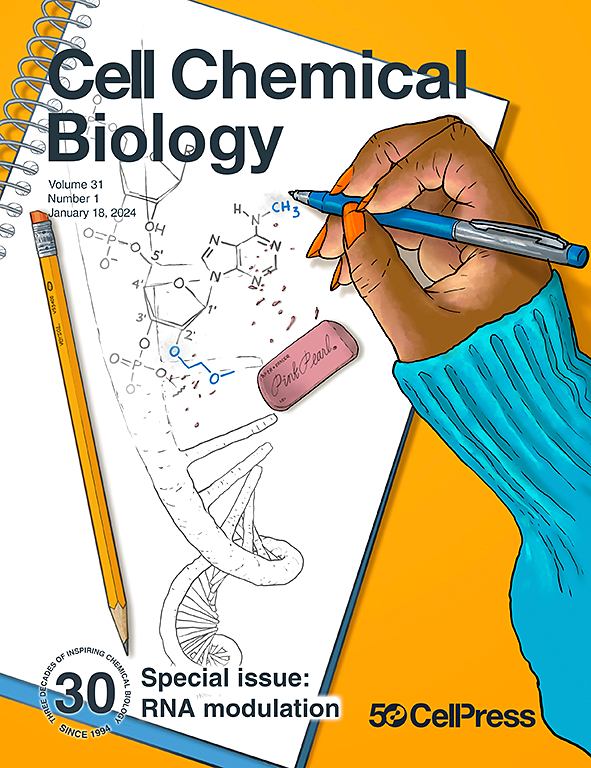Discovery of a mu-opioid receptor modulator that in combination with morphinan antagonists induces analgesia
IF 6.6
1区 生物学
Q1 BIOCHEMISTRY & MOLECULAR BIOLOGY
引用次数: 0
Abstract
Morphinan antagonists, which block opioid effects at mu-opioid receptors, have been studied for their analgesic potential. Previous studies have suggested that these antagonists elicit analgesia with fewer adverse effects in the presence of the mutant mu-opioid receptor (MOR; S196A). However, introducing a mutant receptor for medical applications represents significant challenges. We hypothesize that binding a chemical compound to the MOR may elicit a comparable effect to the S196A mutation. Through high-throughput screening and structure-activity relationship studies, we identified a modulator, 4-(2-(4-fluorophenyl)-4-oxothiazolidin-3-yl)-3-methylbenzoic acid (BPRMU191), which confers agonistic properties to small-molecule morphinan antagonists, which induce G protein-dependent MOR activation. Co-application of BPRMU191 and morphinan antagonists resulted in MOR-dependent analgesia with diminished side effects, including gastrointestinal dysfunction, antinociceptive tolerance, and physical and psychological dependence. Combining BPRMU191 and morphinan antagonists could serve as a potential therapeutic strategy for severe pain with reduced adverse effects and provide an avenue for studying G protein-coupled receptor modulation.


发现一种μ-阿片受体调节剂,与吗啡烷拮抗剂联合使用可产生镇痛效果
吗啡南拮抗剂可阻断μ阿片受体的阿片效应,其镇痛潜力已得到研究。以前的研究表明,这些拮抗剂在存在突变μ阿片受体(MOR;S196A)的情况下可产生镇痛作用,且不良反应较少。然而,引入突变受体用于医疗应用是一项重大挑战。我们假设,将化合物与 MOR 结合可能会产生与 S196A 突变相似的效果。通过高通量筛选和结构-活性关系研究,我们发现了一种调节剂--4-(2-(4-氟苯基)-4-氧代噻唑烷-3-基)-3-甲基苯甲酸(BPRMU191),它能赋予小分子吗啡烷拮抗剂激动特性,而吗啡烷拮抗剂能诱导 G 蛋白依赖的 MOR 激活。将 BPRMU191 和吗啡南拮抗剂联合应用,可产生 MOR 依赖性镇痛,同时减少副作用,包括胃肠道功能障碍、抗痛觉耐受性以及生理和心理依赖性。将 BPRMU191 和吗啡南拮抗剂结合使用,可作为一种潜在的治疗严重疼痛的策略,同时减少不良反应,并为研究 G 蛋白偶联受体调节提供了一条途径。
本文章由计算机程序翻译,如有差异,请以英文原文为准。
求助全文
约1分钟内获得全文
求助全文
来源期刊

Cell Chemical Biology
Biochemistry, Genetics and Molecular Biology-Molecular Medicine
CiteScore
14.70
自引率
2.30%
发文量
143
期刊介绍:
Cell Chemical Biology, a Cell Press journal established in 1994 as Chemistry & Biology, focuses on publishing crucial advances in chemical biology research with broad appeal to our diverse community, spanning basic scientists to clinicians. Pioneering investigations at the chemistry-biology interface, the journal fosters collaboration between these disciplines. We encourage submissions providing significant conceptual advancements of broad interest across chemical, biological, clinical, and related fields. Particularly sought are articles utilizing chemical tools to perturb, visualize, and measure biological systems, offering unique insights into molecular mechanisms, disease biology, and therapeutics.
 求助内容:
求助内容: 应助结果提醒方式:
应助结果提醒方式:


